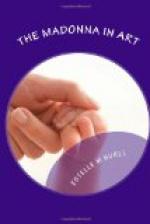We turn from one to another of these three beautiful pictures, always in doubt as to which is the greatest. Fortunately, it is a question which there is no occasion to decide, as every lover of art may be the happy possessor of all three, in that highest mode of possession attained by devoted study.
In each one we have the typical Tuscan landscape, filling the whole picture with its tranquil beauty. The “glad green earth” blossoms with dainty flowers; the fair blue sky above is reflected in the placid surface of a lake. From its shores rise gently undulating hills, where towers show the signs of happy activity. In the foreground of this peaceful scene sits a beautiful woman with two charming children at her knee. They belong to the landscape as naturally as the trees and flowers; they partake of its tranquil, placid happiness.
[Illustration: RAPHAEL.—MADONNA IN THE MEADOW.]
Almost identical in general style of composition, the three pictures show many points of dissimilarity when we come to a closer study of the figures. Considered as a type of womanly beauty, the Belle Jardiniere is perhaps the most commonplace of the three Virgins, or, to put it negatively, the least attractive. She is distinctly of the peasant class, gentle, amiable, and entirely unassuming. The Madonna in the Meadow is a maturer woman, more dignified, more beautiful. The smooth braids of her hair are coiled about the head, accentuating its lovely outline. The falling mantle reveals the finely modelled shoulders. The Madonna of the Goldfinch is a still higher type of loveliness, uniting with gentle dignity a certain delicate, high-bred grace, which Raphael alone could impart. Her face is charmingly framed in the soft hair which falls modestly about it. One wonders if any modern coiffeur could invent so many styles of hair dressing as does this gifted young painter of the sixteenth century.
Turning from the mother to the children, we find the same general types repeated in the three pictures, but with some difference of motif. The Christ-child of the Belle Jardiniere is looking up fondly to his mother. In the Vienna picture he is eagerly interested in the cross which the little St. John gives him. In the Uffizi picture he is more serious, and strokes the goldfinch with an air of abstraction, meditating on the holy things his mother has been reading to him.
The arrangement of the three figures is the same in all the pictures, and is so entirely simple that we forget the greatness of the art. The Virgin, dominating the composition, brings into unity the two smaller figures. This unity is somewhat less perfect in the Belle Jardiniere, because the little St. John is almost neglected in the intense absorption of mother and child in each other.
Once again, in the later days at Rome, Raphael recurred to the pastoral Madonna type of this Florentine period, and painted the picture known as the Casa Alba Madonna. We have again the same smiling landscape and the same charming children, but a Virgin of an altogether new order. A turbaned Roman beauty of superb, Juno-like physique, she does not belong to the idyllic character of her surroundings. It is as if some brilliant exotic had been transplanted from her native haunts to quiet fields, where hitherto the modest lily had bloomed alone.




